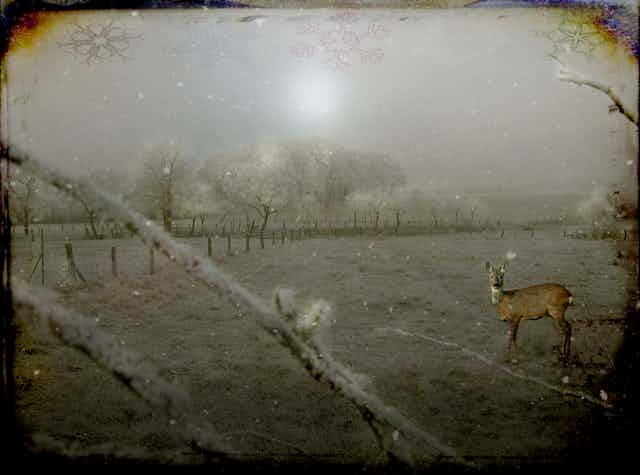Every festive season guarantees a television re-run of the National Lampoon’s Christmas Vacation, with the deflating turkey, incinerated tree, and extreme Griswold household lighting display that is now sufficiently commonplace for the joke to be compromised.
Most modern Christmas films angle for comedy with a touch of sentimental schmaltz. In contrast, literary Christmases frequently tap into the anxiety and sadness that often accompany the “happiest time of year”.
Charles Dickens’ A Christmas Carol (1843) is the quintessential Christmas tale. Even for those who have never read any Dickens, the miserly Ebeneezer Scrooge has permeated our culture, from 1940s Scrooge McDuck cartoons to the Muppets adaptation of A Christmas Carol in 1992.
Money-lender Scrooge’s greed extends to denying the pleasures of Christmas to himself and his employees. The ghosts of Christmas Past, Christmas Present, and Christmas Yet to Come aid Scrooge in reconciling his pain at the loss of a past love and redeeming himself among the living, so that he can find a welcoming place in the world on Christmas day.
As Tara Moore explains, Dickens and other writers in the Victorian period shaped “a certain version of urban Christmas—plum pudding, mourning the lost, holly and hearth-love” that we continue to idealise and reproduce.
Truman Capote’s autobiographical short story A Christmas Memory (1956) transports the theme of mourning happier times and beloved people from the snowy cobblestone streets of London to small-town Alabama.
The seven-year-old narrator, Buddy, describes the pleasures of a poor – but loving and inventive – Christmas with his elderly cousin, complete with scandalous nips of whisky after baking fruitcakes.
This is Buddy’s last Christmas with her, as he subsequently moves to military school. As time passes, dementia erases the cousin’s memories of Buddy and a November finally arrives,
when she cannot rouse herself to exclaim: “Oh my, it’s fruitcake weather!”
Other literary Christmases struggle to even find a bittersweet strand to the holiday. Dostoyevsky’s A Christmas Tree and a Wedding (1848) is a disturbing story in which the narrator recalls a past Christmas party in which a male landowner watches a rich girl playing with a doll.
The landowner calculates that when the girl is old enough marry that her dowry will total half a million roubles; he attempts to kiss the girl and extract a promise of love from her. The wedding of the title, which the narrator has just attended, is revealed to be that of the landowner and the rich girl, held five years after their Christmas meeting.
Clement Clarke Moore’s poem ’Twas the Night Before Christmas (1823) popularised an idyllic children’s vision of Christmas rendered magical by Saint Nicholas and his flying reindeer. In several of Hans Christian Andersen’s fairy tales with festive settings, however, he does not soften his trademark melancholy for the sake of Christmas cheer.

In the little-known story The Fir Tree (1844), a tree is impatient for the day when it will be tall enough to take the exciting journey that other trees in the forest enjoy each December.
The fir tree is blissful when he is felled, transported, and decorated with candles and a gleaming star for a family’s Christmas Eve celebrations. He is then discarded in the household attic and eventually chopped to pieces and tossed on a fire. “Past! past!” the tree cries as he burns, realising that he should have taken pleasure during his lifetime in the forest, rather than eyeing an unknown future.
The Little Match Girl (1845) is similarly heart-rending, as a hungry, barefooted girl attempts to sell matches on snowy streets on New Year’s Eve.
She lights several matches to warm herself and is comforted by a series of visions, including a Christmas scene with a tree shining with “thousands of candles” and a stuffed goose that jumps from its dish,
and waddle[s] along the floor with a knife and fork in its breast, right over to the little girl.
The girl freezes to death on the street. As is typical of Andersen, her lonely death is intended to be a happy ending, as she will join with her grandmother and God in heaven.
Christmas is a backdrop for confronting feelings of isolation, strangeness and escalating family tensions in a range of fiction. Peter Carey’s Oscar and Lucinda (1988), set in the 19th century, is a striking example of Christmas serving as a lightning rod for intergenerational conflict.
Oscar’s father, Theophilus, is a fundamentalist Christian preacher who shuns Christmas feasting and celebration as pagan in origin. The servants covertly cook a plum pudding for Oscar, but his father catches him eating the “fruit of Satan” after one life-changing spoonful.
Theophilus strikes his son, forcing him to spit out the forbidden pleasure. Oscar, seeking a divine sign, asks God “if it be Thy will that Thy people eat pudding, then smite him!”. His father is soon bleeding with an injury and Oscar’s rejection of his father’s religion is set in motion.
In literature, as in our lived experiences of Christmas, the expectations of family, togetherness, and plenitude can heighten a sense of loneliness, loss, and conflict.
While there are many cheerful stories of Christmas, for children in particular, a significant number of literary Christmases scratch away at its twinkling veneer of tinsel and goodwill.
There’s an element of humbug in the mythology of Christmas, as Scrooge would have it, after all.

